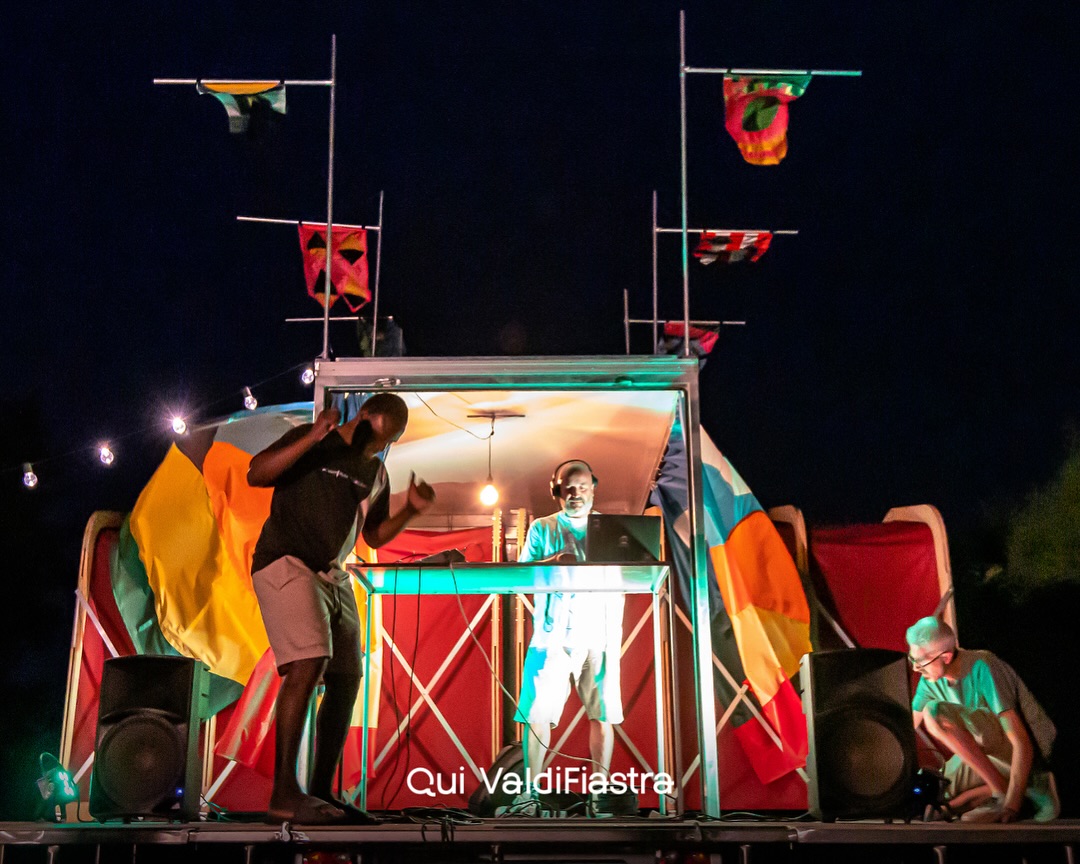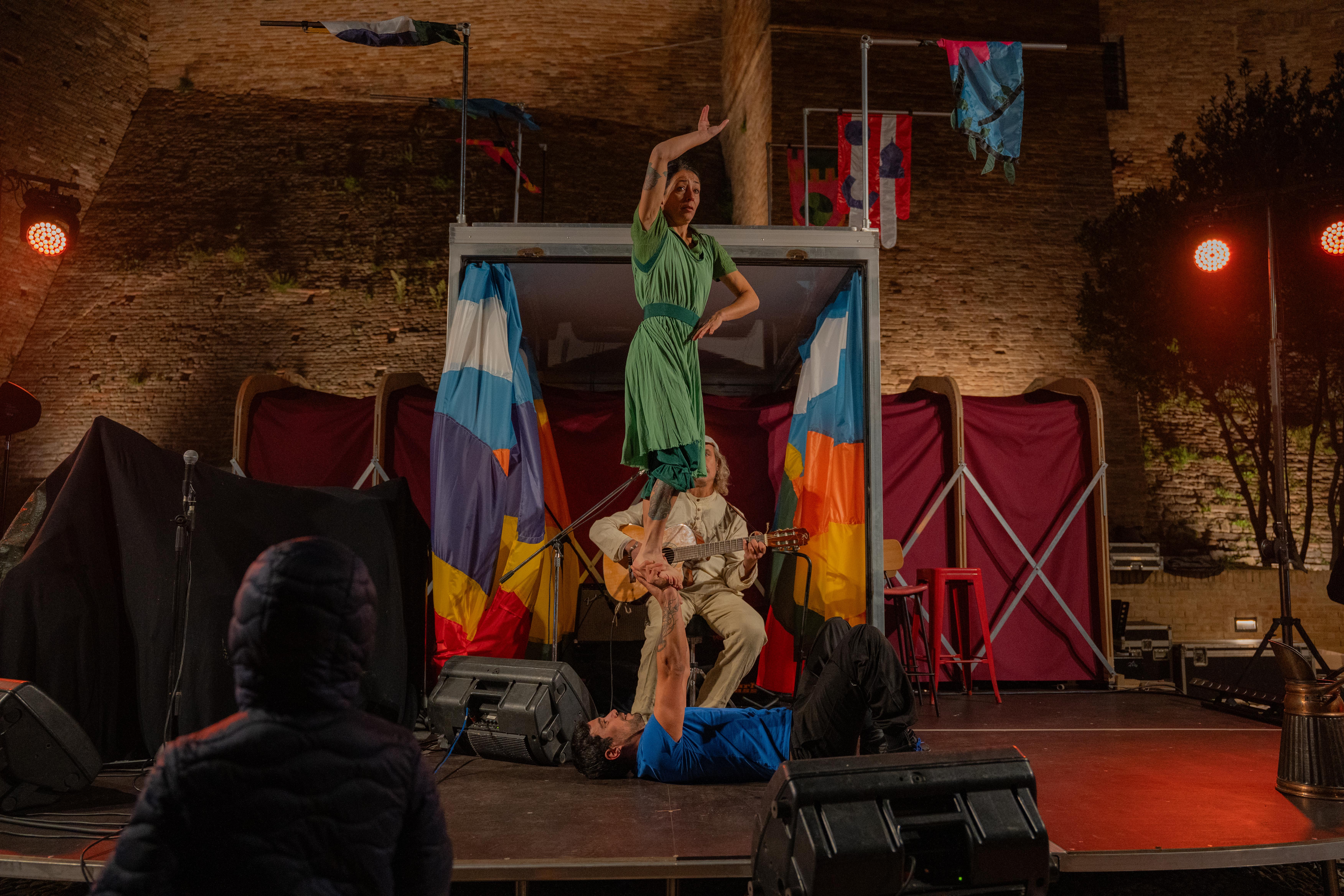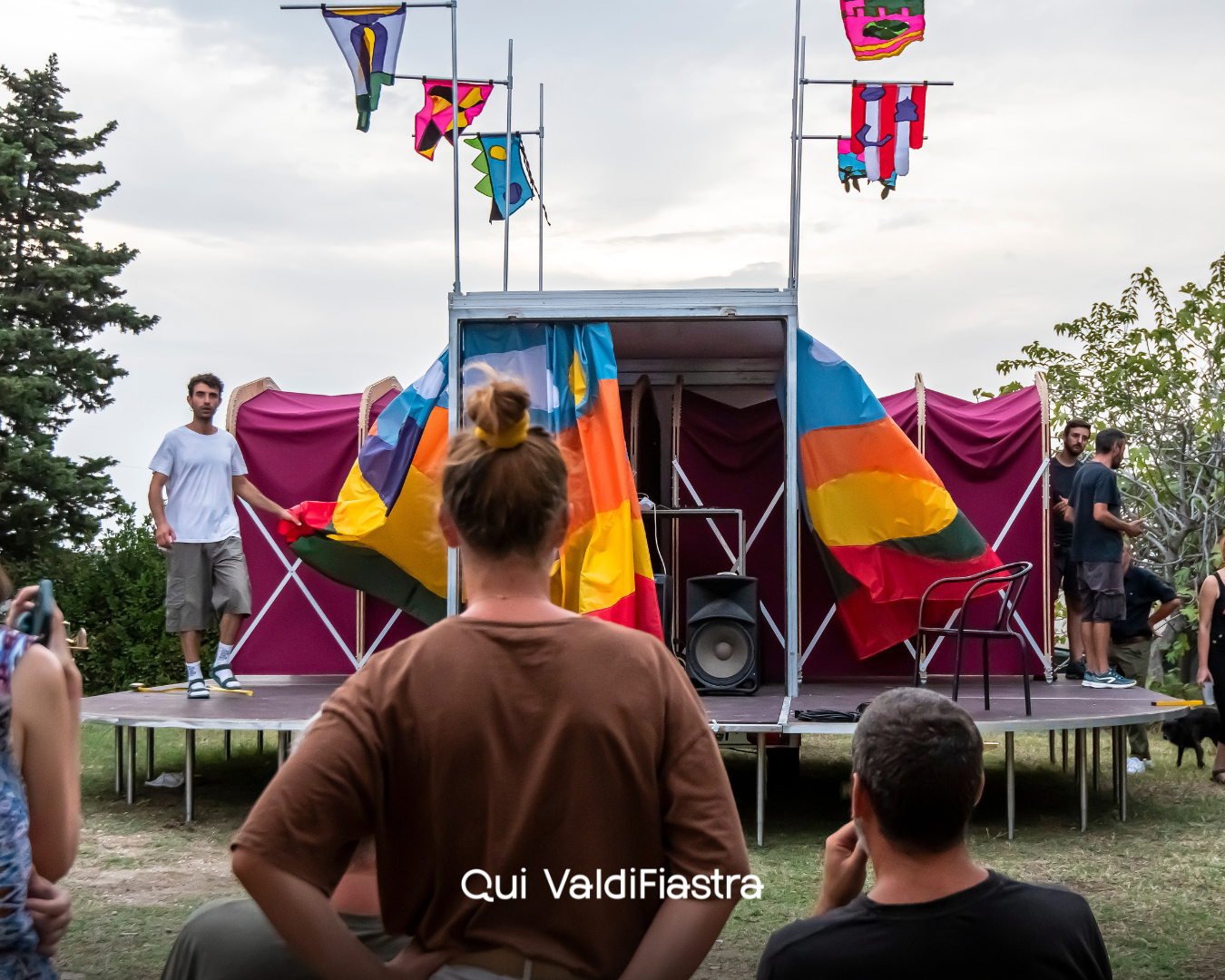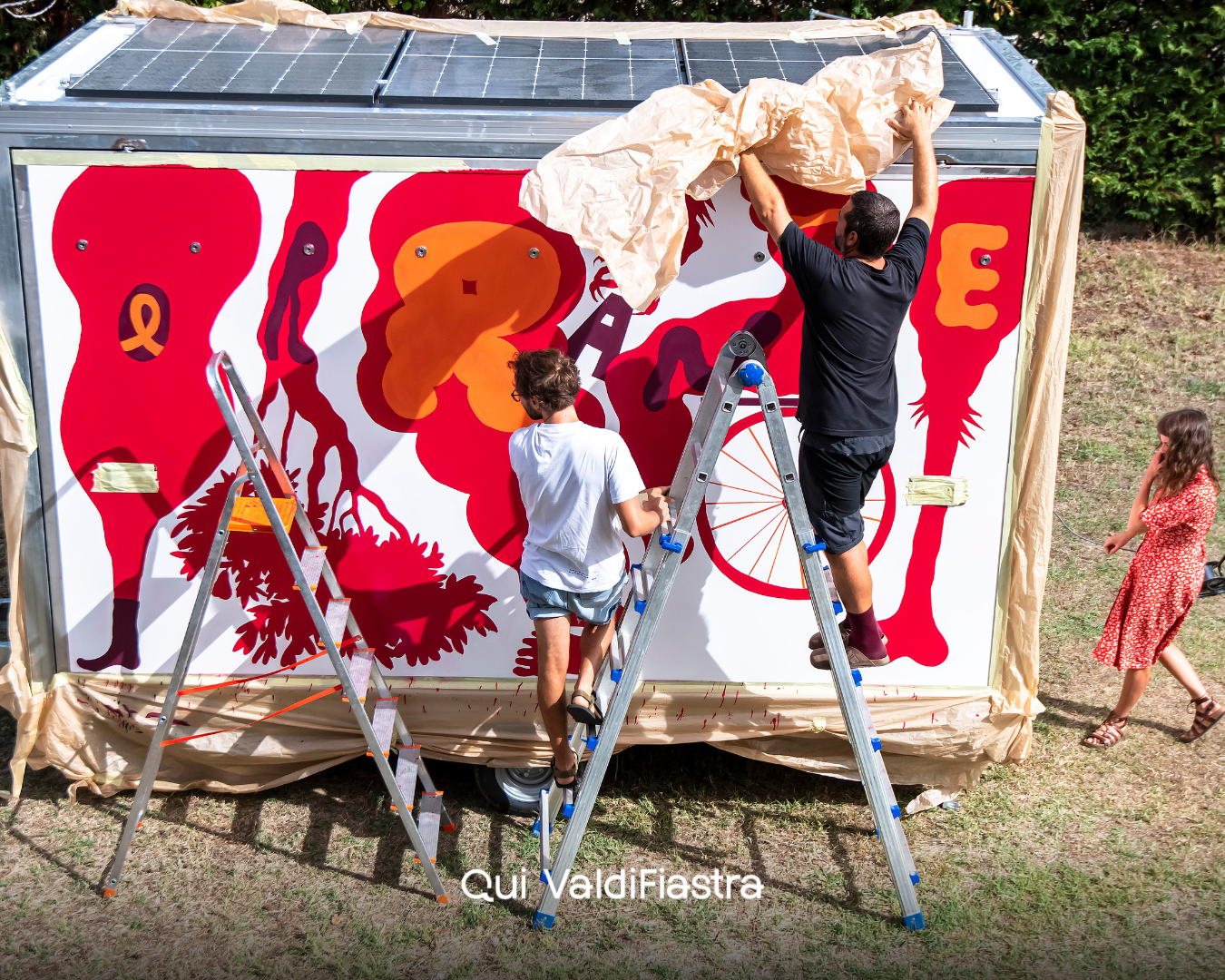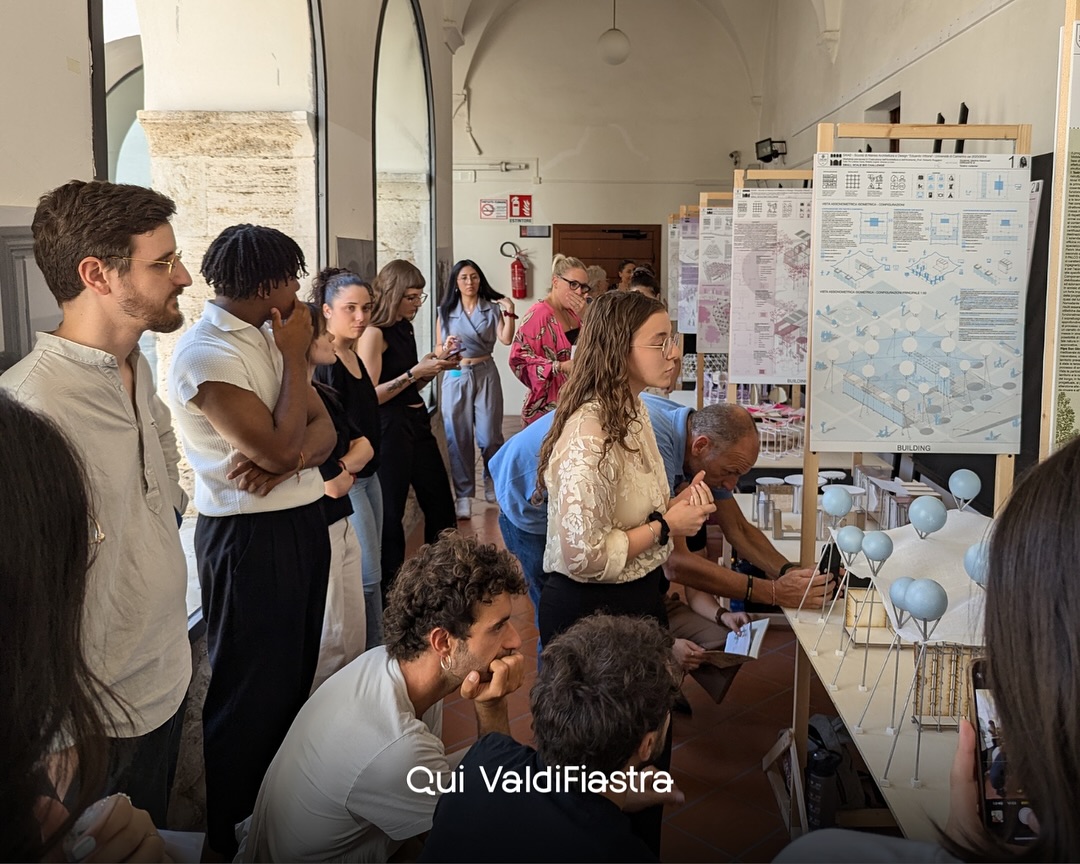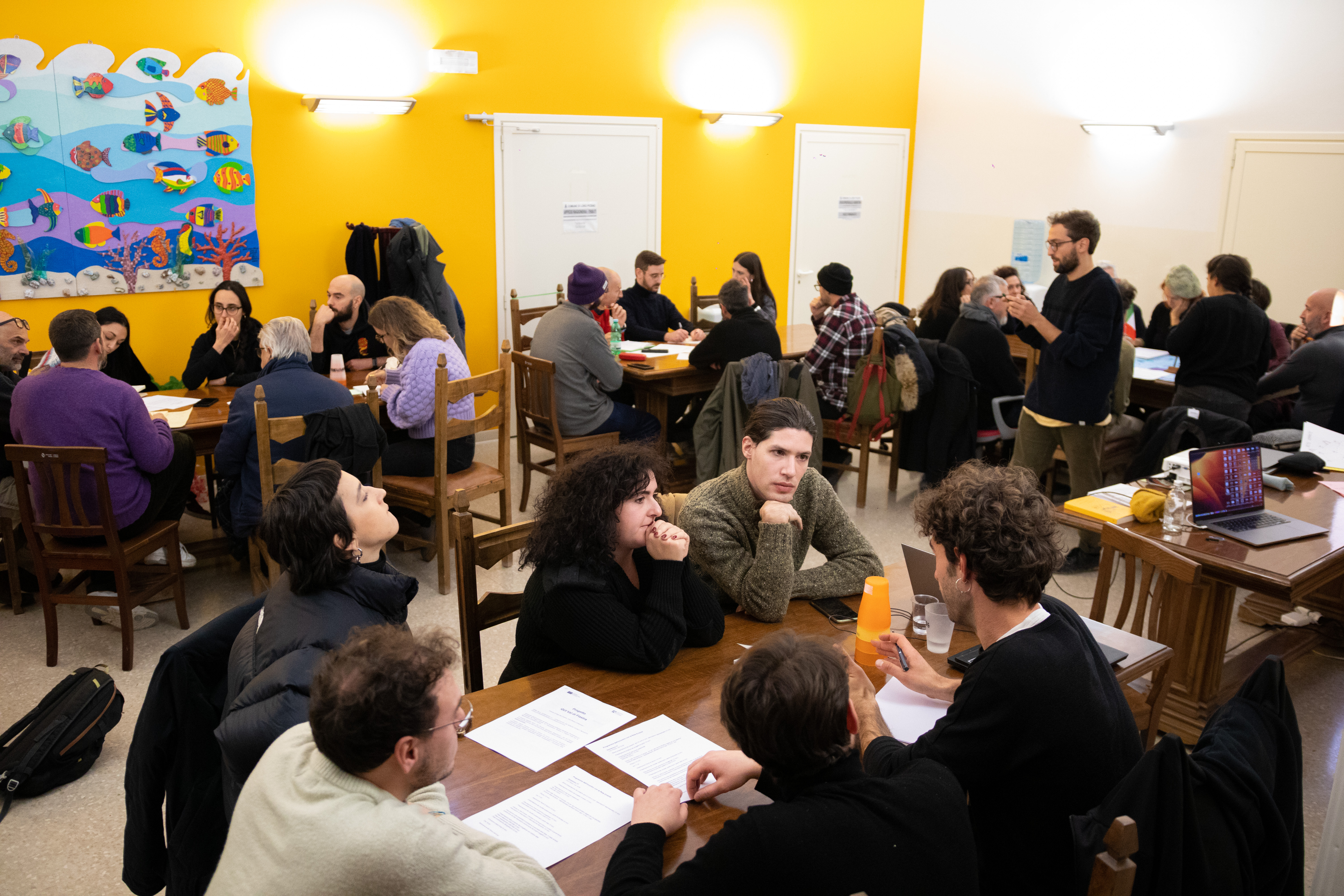Prioritising the places and people that need it the most
Errante - Traveling Festival
Errante – a mobile, self-sustaining cultural space fostering inclusion, sustainability in EU margins
Errante is a mobile, self-sustaining cultural infrastructure that brings art, performance, and community-driven events to rural and underserved areas, fostering inclusion, sustainability, and innovation. Designed through a collaborative and circular approach, it integrates renewable energy, modular design, and shared resources to create adaptive cultural spaces.
It rethinks how culture is produced and experienced, making it accessible, low-impact, and community-led.
It rethinks how culture is produced and experienced, making it accessible, low-impact, and community-led.
Italy
Regional
Marche region
It addresses urban-rural linkages
It refers to other types of transformations (soft investment)
Yes
2024-11-09
No
No
No
As a representative of an organisation
Errante is a mobile, self-sustaining cultural infrastructure designed to bring high-quality artistic and cultural experiences to rural and marginalized communities, overcoming geographic and financial barriers. Built as a trailer with a deployable stage, it offers a flexible, adaptable solution that can travel between remote locations, ensuring accessibility for cultural programming even in the most isolated areas.
It aims to increase cultural accessibility, foster community participation, and create a sustainable, off-grid model for cultural events–a mission particularly vital in the Fiastra Valley, where the 2016 earthquake hit most towns, leaving lasting impacts on the environment, aesthetics, and social fabric: many cultural spaces were lost, and rebuilding efforts have often prioritized essential infrastructure over artistic and communal spaces. Errante provides a low-impact, mobile place on wheels that reactivates these territories without contributing to further land consumption.
Target groups:
Residents of rural/underserved areas, especially youth, elderly, and marginalized groups, who lack cultural participation due to marginality of geographical context.
Artists, cultural associations, and municipalities struggling with limited exhibition spaces or seeking to engage remote areas through their interventions.
Specific objectives – achieved through a co-design process with 21+ local associations, the University of Camerino, and design architects:
Develop a fully mobile and energy-autonomous cultural unit.
Create a participatory, networking, governance model.
Activate underutilized public spaces through a community-driven cultural program.
Key results:
10 cultural events held, engaging 5000 participants (residents and tourists).
10% increase in tourism, supporting local businesses and creating temporary jobs for artists and event coordinators.
300 young people engaged in creative workshops.
30% rise in elderly and marginalized group participation.
It aims to increase cultural accessibility, foster community participation, and create a sustainable, off-grid model for cultural events–a mission particularly vital in the Fiastra Valley, where the 2016 earthquake hit most towns, leaving lasting impacts on the environment, aesthetics, and social fabric: many cultural spaces were lost, and rebuilding efforts have often prioritized essential infrastructure over artistic and communal spaces. Errante provides a low-impact, mobile place on wheels that reactivates these territories without contributing to further land consumption.
Target groups:
Residents of rural/underserved areas, especially youth, elderly, and marginalized groups, who lack cultural participation due to marginality of geographical context.
Artists, cultural associations, and municipalities struggling with limited exhibition spaces or seeking to engage remote areas through their interventions.
Specific objectives – achieved through a co-design process with 21+ local associations, the University of Camerino, and design architects:
Develop a fully mobile and energy-autonomous cultural unit.
Create a participatory, networking, governance model.
Activate underutilized public spaces through a community-driven cultural program.
Key results:
10 cultural events held, engaging 5000 participants (residents and tourists).
10% increase in tourism, supporting local businesses and creating temporary jobs for artists and event coordinators.
300 young people engaged in creative workshops.
30% rise in elderly and marginalized group participation.
Cultural accessibility
Mobile architecture
Rural revitalization
Sustainable Infrastructure
Mutualism
Errante is an off-grid mobile cultural platform that fully integrates renewable energy, eco-friendly materials, and circular economy principles: it ensures complete energy autonomy through a photovoltaic system composed of 3 solar panels (installed on the trailer’s roof and selected based on the available surface area to maximize energy capture) an inverter, and storage batteries, guaranteeing autonomy for up to 8 hours in the evening.
Energy is continuously replenished during setup and events, eliminating reliance on external power sources and reducing emissions. An electric vehicle for transport keeps the system carbon-efficient, further minimizing environmental impact and reinforcing sustainable mobility.
The structure is built using lightweight and modular materials, minimizing environmental impact during construction and transportation; also, the modular design enables quick assembly and disassembly, lowering resource consumption; scenographic elements are fully modular and customizable too, allowing each event to have a unique visual identity while ensuring fast, simple adaptations without generating unnecessary waste.
The use of durable, adaptable and reusable materials ensures a long lifespan, reducing waste and reinforcing Errante’s commitment to sustainability. This approach aligns with its minimal-impact philosophy, as the unit does not rely on new permanent structures but instead repurposes existing rural spaces, preventing soil sealing, preserving the natural landscape, and promoting sustainable land use. Avoiding large-scale construction, which disrupts habitats and depletes resources, Errante integrates cultural activities seamlessly into their surroundings rather than imposing infrastructure on the environment. Its energy-autonomous, modular design further reduces its footprint, allowing it to function off-grid while remaining adaptable, scalable, and low-carbon.
Energy is continuously replenished during setup and events, eliminating reliance on external power sources and reducing emissions. An electric vehicle for transport keeps the system carbon-efficient, further minimizing environmental impact and reinforcing sustainable mobility.
The structure is built using lightweight and modular materials, minimizing environmental impact during construction and transportation; also, the modular design enables quick assembly and disassembly, lowering resource consumption; scenographic elements are fully modular and customizable too, allowing each event to have a unique visual identity while ensuring fast, simple adaptations without generating unnecessary waste.
The use of durable, adaptable and reusable materials ensures a long lifespan, reducing waste and reinforcing Errante’s commitment to sustainability. This approach aligns with its minimal-impact philosophy, as the unit does not rely on new permanent structures but instead repurposes existing rural spaces, preventing soil sealing, preserving the natural landscape, and promoting sustainable land use. Avoiding large-scale construction, which disrupts habitats and depletes resources, Errante integrates cultural activities seamlessly into their surroundings rather than imposing infrastructure on the environment. Its energy-autonomous, modular design further reduces its footprint, allowing it to function off-grid while remaining adaptable, scalable, and low-carbon.
Errante integrates aesthetics and quality of experience through a participatory, site-responsive modular design.
The exterior was shaped through a collaborative illustration workshop led by artist Nicola Alessandrini, where young participants from local associations designed a dynamic, ever-evolving canvas reflecting the communities it engages with. A participatory fabric design workshop with Maëlle Berthoumieu and local participatory design collective “Les Friches” enriched the unit’s visual identity, creating illustrated textiles fully customizable for each event while allowing scenographic elements to adapt based on different cultural contexts.
The first 2 workshops are deeply tied to a transformative process, starting from elements of the local identity and evolving into a new, contemporary, and more inclusive identity that remains rooted in tradition; it ensures that Errante keeps a connection to local traditional narratives while representing a forward-looking platform that embraces diversity and contemporary artistic expression.
For the interiors, an auto-construction workshop led by architects Matteo Andrenelli and Lorenzo Malloni developed a deployable tunnel, expanding the spatial possibilities of the unit while reinforcing its adaptable and immersive nature, and led to the selection of materials that prioritized wood, aluminum, and modular components for durability and adaptability.
The modular design applies not only to the core structure but also to the scenographic elements of Errante, which acts as a spatial device that generates places, expanding beyond its core unit through secondary and collateral structures that adapt to each event and enhance both stage identity and audience engagement–creating a wider, more immersive cultural and artistic setting that makes each event unique and deeply connected to its surroundings. This customizability ensures its integration into urban spaces, traditional rural villages, and remote settings.
The exterior was shaped through a collaborative illustration workshop led by artist Nicola Alessandrini, where young participants from local associations designed a dynamic, ever-evolving canvas reflecting the communities it engages with. A participatory fabric design workshop with Maëlle Berthoumieu and local participatory design collective “Les Friches” enriched the unit’s visual identity, creating illustrated textiles fully customizable for each event while allowing scenographic elements to adapt based on different cultural contexts.
The first 2 workshops are deeply tied to a transformative process, starting from elements of the local identity and evolving into a new, contemporary, and more inclusive identity that remains rooted in tradition; it ensures that Errante keeps a connection to local traditional narratives while representing a forward-looking platform that embraces diversity and contemporary artistic expression.
For the interiors, an auto-construction workshop led by architects Matteo Andrenelli and Lorenzo Malloni developed a deployable tunnel, expanding the spatial possibilities of the unit while reinforcing its adaptable and immersive nature, and led to the selection of materials that prioritized wood, aluminum, and modular components for durability and adaptability.
The modular design applies not only to the core structure but also to the scenographic elements of Errante, which acts as a spatial device that generates places, expanding beyond its core unit through secondary and collateral structures that adapt to each event and enhance both stage identity and audience engagement–creating a wider, more immersive cultural and artistic setting that makes each event unique and deeply connected to its surroundings. This customizability ensures its integration into urban spaces, traditional rural villages, and remote settings.
Socio-cultural exclusion in rural and marginalized areas is a systemic issue where access is dictated by geography and financial means. In these areas, cultural venues are distant, ticket prices reflect the difficulty of access, and the result is a growing divide between urban cultural abundance and rural cultural scarcity, even more severe in this territory since the aftermath of the 2016 earthquake. Errante disrupts this cycle by physically bringing artistic and cultural experiences to these underserved communities, offering events at reduced costs, and eliminating logistical barriers; it reaches places where traditional cultural programming would not be viable, ensuring that participation in culture is not a privilege for the few but a right accessible to all.
Errante’s commitment follows a clear mutualistic approach: the 21+ associations and local community representatives involved in its construction are now part of the Errante Network, which collectively manages its governance through an open, participatory framework, ensuring that local voices actively shape programming and resource allocation. This way, cultural production becomes a shared responsibility and reinforces a sense of belonging and ownership within the community. A key element of this mutualistic system is the shared use of technical resources and equipment within the Network, which significantly reduces fixed event costs and makes high-quality cultural infrastructure accessible even to smaller associations with limited budgets.
Errante’s flexible and adaptable nature allows it to activate spaces where social segregation and isolation are prevalent, serving as a gathering point where communities can interact, share, and collectively participate in cultural life: vulnerable community members, often excluded from mainstream cultural offerings due to economic or social barriers, find in Errante an inclusive, welcoming space where they can access, contribute to, and shape cultural experiences.
Errante’s commitment follows a clear mutualistic approach: the 21+ associations and local community representatives involved in its construction are now part of the Errante Network, which collectively manages its governance through an open, participatory framework, ensuring that local voices actively shape programming and resource allocation. This way, cultural production becomes a shared responsibility and reinforces a sense of belonging and ownership within the community. A key element of this mutualistic system is the shared use of technical resources and equipment within the Network, which significantly reduces fixed event costs and makes high-quality cultural infrastructure accessible even to smaller associations with limited budgets.
Errante’s flexible and adaptable nature allows it to activate spaces where social segregation and isolation are prevalent, serving as a gathering point where communities can interact, share, and collectively participate in cultural life: vulnerable community members, often excluded from mainstream cultural offerings due to economic or social barriers, find in Errante an inclusive, welcoming space where they can access, contribute to, and shape cultural experiences.
From the outset, Errante aimed to expand a mutualistic network between local organizations, municipalities, and community members, leading to the shared governance and management of the Unit and its technical equipment. This network, Rete Errante, comprises 21+ associations, 2 universities, and local cultural stakeholders.
The co-creation process unfolded through stages of engagement: surveys and round-tables identified the cultural and logistical needs of each community and pointed out the design guidelines; 4 workshops at the University of Camerino engaged students, professors, and professionals during 2 months in developing 15 architectural concepts with technical drawings and 1:20 scale 3d prototypes; construction and customization workshops took place over 4 days of collaborative sessions and saw network members, students, and professionals work in teams following participatory methods to develop different aspects of the mobile unit–one group focused on fabrics and scenographic structures, another on illustration and painting, and a third on the structural components of the interiors of Errante.
Errante’s programming is entirely community-driven: decision-making is managed through an open governance Model, where members of Rete Errante choose programming, operational logistics, and long-term strategy, fostering a sense of ownership while reinforcing the idea that the Unit is a shared resource rather than an external intervention. This way, local organizations can shape cultural production according to their needs, strengthening the Valley’s creative and social fabric.
The impact of our approach was evident during the project's official launch event on November 9th, 2024, in Loro Piceno: marking the culmination of nearly a year of collective effort, it was a moment of celebration and validation for residents and organizations that had contributed to the project, and reinforced Errante as a replicable Model for community-driven cultural infrastructure
The co-creation process unfolded through stages of engagement: surveys and round-tables identified the cultural and logistical needs of each community and pointed out the design guidelines; 4 workshops at the University of Camerino engaged students, professors, and professionals during 2 months in developing 15 architectural concepts with technical drawings and 1:20 scale 3d prototypes; construction and customization workshops took place over 4 days of collaborative sessions and saw network members, students, and professionals work in teams following participatory methods to develop different aspects of the mobile unit–one group focused on fabrics and scenographic structures, another on illustration and painting, and a third on the structural components of the interiors of Errante.
Errante’s programming is entirely community-driven: decision-making is managed through an open governance Model, where members of Rete Errante choose programming, operational logistics, and long-term strategy, fostering a sense of ownership while reinforcing the idea that the Unit is a shared resource rather than an external intervention. This way, local organizations can shape cultural production according to their needs, strengthening the Valley’s creative and social fabric.
The impact of our approach was evident during the project's official launch event on November 9th, 2024, in Loro Piceno: marking the culmination of nearly a year of collective effort, it was a moment of celebration and validation for residents and organizations that had contributed to the project, and reinforced Errante as a replicable Model for community-driven cultural infrastructure
Errante is a Model of multi-level collaboration, integrating diverse competencies and knowledge fields to create a community-driven cultural infrastructure that is both sustainable and replicable.
At the local level, 21 cultural associations, municipalities, and residents shaped the project from the outset: a detailed mapping of cultural actors in Ripe San Ginesio, Colmurano, and Loro Piceno led to surveys and participatory workshops that identified community needs, and stakeholders played a direct role in decision-making, from defining the unit’s functionality to co-managing its programming and governance; experts in social sciences, community engagement, and cultural management helped structure an inclusive participatory process that empowered local organizations to take ownership of the project.
At the regional level, the University of Camerino contributed research, design expertise, and student involvement: through structured workshops, students and faculty from architecture, environmental design, and engineering developed scalable solutions using digital Modeling and fabrication techniques; their involvement ensured that Errante was structurally sound, mobile, and energy-efficient. Meanwhile, experts in architectural design and illustration guided the selection of lightweight, modular, and locally sourced materials, reducing environmental impact while maximizing durability.
At the national and European levels, Errante shared methodologies and integrated best practices with similar projects, refining its governance Model and technical design through introductory visits, comparative research and transnational exchanges: inspired by case studies like PaPoMo in Marseille, Octobus in Grenoble, and Roaming Market in London, we framed Errante to incorporate modular design, participatory urban planning, and off-grid energy solutions to optimize its adaptability to underserved areas and reduce logistical barriers.
At the local level, 21 cultural associations, municipalities, and residents shaped the project from the outset: a detailed mapping of cultural actors in Ripe San Ginesio, Colmurano, and Loro Piceno led to surveys and participatory workshops that identified community needs, and stakeholders played a direct role in decision-making, from defining the unit’s functionality to co-managing its programming and governance; experts in social sciences, community engagement, and cultural management helped structure an inclusive participatory process that empowered local organizations to take ownership of the project.
At the regional level, the University of Camerino contributed research, design expertise, and student involvement: through structured workshops, students and faculty from architecture, environmental design, and engineering developed scalable solutions using digital Modeling and fabrication techniques; their involvement ensured that Errante was structurally sound, mobile, and energy-efficient. Meanwhile, experts in architectural design and illustration guided the selection of lightweight, modular, and locally sourced materials, reducing environmental impact while maximizing durability.
At the national and European levels, Errante shared methodologies and integrated best practices with similar projects, refining its governance Model and technical design through introductory visits, comparative research and transnational exchanges: inspired by case studies like PaPoMo in Marseille, Octobus in Grenoble, and Roaming Market in London, we framed Errante to incorporate modular design, participatory urban planning, and off-grid energy solutions to optimize its adaptability to underserved areas and reduce logistical barriers.
Errante emerged from a multidisciplinary collaboration across architecture, sustainability, cultural management, engineering, social sciences, and community engagement. It brought together academic researchers, cultural practitioners, and a network of local associations, from elderly community groups and local heritage organizations (Pro Loco) to young festival organizers, integrating music, theater, visual arts, cinema, and interdisciplinary performances into its cultural programming.
Errante applies Tactical Urbanism to reimagine public space through temporary, low-cost, and scalable interventions, bringing culture to rural and underserved areas. Its mobile, adaptable stage transforms streets, plazas, and squares into creative hubs, fostering new connections between people and public spaces while serving as a dynamic tool for placemaking.
The University of Camerino was key in architectural and engineering aspects, with students and faculty from the School of Architecture and Design developing modular, mobile, and energy-efficient solutions: their expertise in digital fabrication and sustainable construction allowed for a scalable and adaptable design. Cultural associations, theater companies, independent curators, and grassroots music collectives contributed their expertise, ensuring that the unit was not just functional but also a meaningful artistic space shaped by the communities it serves. Cultural managers and social scientists structured participatory workshops, where associations, municipalities, and residents co-designed the Unit and its governance model. Sustainability experts guided material selection and renewable energy integration, enabling the unit to operate entirely off-grid– using solar panels and lightweight demonstrated the potential of low-carbon cultural infrastructure. Local craftsmen specializing in carpentry, textile arts, and scenography refined the unit’s durability and adaptability, combining traditional skills with innovative design.
Errante applies Tactical Urbanism to reimagine public space through temporary, low-cost, and scalable interventions, bringing culture to rural and underserved areas. Its mobile, adaptable stage transforms streets, plazas, and squares into creative hubs, fostering new connections between people and public spaces while serving as a dynamic tool for placemaking.
The University of Camerino was key in architectural and engineering aspects, with students and faculty from the School of Architecture and Design developing modular, mobile, and energy-efficient solutions: their expertise in digital fabrication and sustainable construction allowed for a scalable and adaptable design. Cultural associations, theater companies, independent curators, and grassroots music collectives contributed their expertise, ensuring that the unit was not just functional but also a meaningful artistic space shaped by the communities it serves. Cultural managers and social scientists structured participatory workshops, where associations, municipalities, and residents co-designed the Unit and its governance model. Sustainability experts guided material selection and renewable energy integration, enabling the unit to operate entirely off-grid– using solar panels and lightweight demonstrated the potential of low-carbon cultural infrastructure. Local craftsmen specializing in carpentry, textile arts, and scenography refined the unit’s durability and adaptability, combining traditional skills with innovative design.
Errante is a fully mobile and self-sustaining cultural unit, bringing high-quality artistic programming to communities that would otherwise be left out. Unlike conventional institutions that require audiences to travel long distances at high costs, Errante moves where culture is needed, eliminating financial and geographical barriers. This shift from stationary to mobile infrastructure is a fundamental innovation in how cultural spaces function, making them responsive, flexible, and inclusive.
Beyond mobility, Errante is a politically and socially innovative model: unlike traditional top-down cultural institutions, Rete Errante is a cooperative framework where decisions about programming, logistics, and artistic direction are shared among 21+ local associations, municipalities, and cultural operators. This participatory approach challenges conventional governance models, decentralizing power and ensuring that cultural production remains collectively owned, context-sensitive, and democratically managed. Errante also offers a radical redistribution of agency, giving rural communities the tools to shape their cultural ecosystems. Furthermore, the associations that are part of Rete Errante directly benefit from access to Errante's infrastructure and services, gaining a flexible platform to host their cultural activities, expand their outreach, and strengthen their organizational capacity.
As a new model of off-grid cultural activation, Errante proves that vibrant cultural spaces can exist outside conventional power infrastructures: while standard venues depend on external energy sources and permanent facilities, limiting their reach and sustainability, Errante is designed for energy autonomy, allowing it to turn any public space into a performance venue. More than a technical solution, this liberates culture from fixed locations and external dependencies, reinforcing its accessibility and adaptability to different territories and social conditions.
Beyond mobility, Errante is a politically and socially innovative model: unlike traditional top-down cultural institutions, Rete Errante is a cooperative framework where decisions about programming, logistics, and artistic direction are shared among 21+ local associations, municipalities, and cultural operators. This participatory approach challenges conventional governance models, decentralizing power and ensuring that cultural production remains collectively owned, context-sensitive, and democratically managed. Errante also offers a radical redistribution of agency, giving rural communities the tools to shape their cultural ecosystems. Furthermore, the associations that are part of Rete Errante directly benefit from access to Errante's infrastructure and services, gaining a flexible platform to host their cultural activities, expand their outreach, and strengthen their organizational capacity.
As a new model of off-grid cultural activation, Errante proves that vibrant cultural spaces can exist outside conventional power infrastructures: while standard venues depend on external energy sources and permanent facilities, limiting their reach and sustainability, Errante is designed for energy autonomy, allowing it to turn any public space into a performance venue. More than a technical solution, this liberates culture from fixed locations and external dependencies, reinforcing its accessibility and adaptability to different territories and social conditions.
The Methodology is based on 4 phases:
1: Context analysis & community engagement
Mapping of cultural associations and stakeholders was conducted firstly in Macerata province and then in the Marche region, followed by surveys and participatory workshops where associations, residents, and municipalities defined their needs for mobile cultural infrastructure and shaped the functional requirements of the unit and a first set of design guidelines. A comparative study of similar European projects provided references for sustainable and mobile cultural spaces.
2: Co-design & prototyping
Starting from the design guidelines the University of Camerino launched a collaborative design workshop with students, professors, and professionals specializing in architecture, environmental sustainability, and digital fabrication: it produced 15 architectural concepts, each presented with technical drawings and 1:20 scale prototypes that, using a digital design-to-production workflow, were evaluated based on mobility, modularity, and energy efficiency. The selected design was refined in coordination with the Errante network to ensure it met the functional and aesthetic needs of the community.
3: Construction
A four-day construction workshop structured through participatory methods brought together community members, cultural associations, and UNICAM students, supervised by engineers, architects, and craftsmen. Teams were divided into 3 working groups:
Textile & spatial structures (designing illustrated fabrics and banners).
Illustration & painting (creating the visual identity of the unit).
Woodwork & assembly (building the modular structures).
4: Governance & launch
The Governance Model, established by the Errante network, implies that decisions on programming, maintenance, and future adaptations are made collectively among the 21+ associations. The launch in November 2024 marked the beginning of a rotating cultural program designed in collaboration with local communities
1: Context analysis & community engagement
Mapping of cultural associations and stakeholders was conducted firstly in Macerata province and then in the Marche region, followed by surveys and participatory workshops where associations, residents, and municipalities defined their needs for mobile cultural infrastructure and shaped the functional requirements of the unit and a first set of design guidelines. A comparative study of similar European projects provided references for sustainable and mobile cultural spaces.
2: Co-design & prototyping
Starting from the design guidelines the University of Camerino launched a collaborative design workshop with students, professors, and professionals specializing in architecture, environmental sustainability, and digital fabrication: it produced 15 architectural concepts, each presented with technical drawings and 1:20 scale prototypes that, using a digital design-to-production workflow, were evaluated based on mobility, modularity, and energy efficiency. The selected design was refined in coordination with the Errante network to ensure it met the functional and aesthetic needs of the community.
3: Construction
A four-day construction workshop structured through participatory methods brought together community members, cultural associations, and UNICAM students, supervised by engineers, architects, and craftsmen. Teams were divided into 3 working groups:
Textile & spatial structures (designing illustrated fabrics and banners).
Illustration & painting (creating the visual identity of the unit).
Woodwork & assembly (building the modular structures).
4: Governance & launch
The Governance Model, established by the Errante network, implies that decisions on programming, maintenance, and future adaptations are made collectively among the 21+ associations. The launch in November 2024 marked the beginning of a rotating cultural program designed in collaboration with local communities
Errante embeds a transferable Model, whose key elements—Methodology, governance, technology, and design—can be replicated across regions, communities, and cultural initiatives. To facilitate this process, we have delivered Guidelines for the construction of the Mobile Structure "Errante" (attached), providing clear instructions for associations, festivals, and cultural organizations interested in implementing similar solutions.
1. Lightweight, mobile, and self-sustaining structure: the open-source blueprints and construction guidelines provide technical instructions and design principles to build similar mobile units using locally available materials; its modular system allows the structure to adjust in size and function, making it adaptable for performances, educational workshops, community gatherings and more while ensuring easy transport and reassembly in different locations.
2. Off-grid renewable energy system—integrating solar panels, an inverter, and battery storage: it enables the Unit to operate independently of external power sources, making it viable in isolated rural areas where infrastructure is lacking, reducing carbon footprints and lowering operational costs of event production.
3. Mutualistic governance framework: built on a network of associations, municipalities, and cultural stakeholders, the Rete Errante is designed to be adaptable to other rural and peripheral regions, facilitating the creation of decentralized, community-owned cultural spaces that encourage co-management, shared resources, and long-term sustainability, reducing dependency on institutional funding and fostering stronger local ownership over cultural infrastructure.
4. Co-design and participatory construction: involving local communities, universities, and professionals, it is a replicable method for developing flexible, place-specific cultural spaces– combining context analysis, participatory design workshops, prototyping, hands-on construction, and community-led activation
1. Lightweight, mobile, and self-sustaining structure: the open-source blueprints and construction guidelines provide technical instructions and design principles to build similar mobile units using locally available materials; its modular system allows the structure to adjust in size and function, making it adaptable for performances, educational workshops, community gatherings and more while ensuring easy transport and reassembly in different locations.
2. Off-grid renewable energy system—integrating solar panels, an inverter, and battery storage: it enables the Unit to operate independently of external power sources, making it viable in isolated rural areas where infrastructure is lacking, reducing carbon footprints and lowering operational costs of event production.
3. Mutualistic governance framework: built on a network of associations, municipalities, and cultural stakeholders, the Rete Errante is designed to be adaptable to other rural and peripheral regions, facilitating the creation of decentralized, community-owned cultural spaces that encourage co-management, shared resources, and long-term sustainability, reducing dependency on institutional funding and fostering stronger local ownership over cultural infrastructure.
4. Co-design and participatory construction: involving local communities, universities, and professionals, it is a replicable method for developing flexible, place-specific cultural spaces– combining context analysis, participatory design workshops, prototyping, hands-on construction, and community-led activation
Errante challenges the inequities in cultural access in rural areas, environmental sustainability, and social exclusion through a concrete, locally-driven solution that can be scaled and adapted to different contexts.
1. Cultural infrastructure in the EU is often concentrated in urban centers, leaving rural and marginalized communities disconnected from artistic and cultural opportunities. Traditional venues require high investments, rely on fixed locations, and exclude those who cannot afford or physically reach them. Errante breaks this cycle by proving that culture does not need permanent buildings—it needs mobility, adaptability, and inclusivity: by physically reaching underserved areas, it eliminates geographical and financial barriers, ensuring that participation in culture is not a privilege but a right.
2. Our project addressed the growing urgency for sustainable cultural infrastructure: while traditional cultural events and venues consume large amounts of energy resources, Errante operates entirely off-grid, powered by a renewable energy system; its lightweight, modular design prioritizes locally sourced materials, reducing construction waste and creating a circular economy Model.
3. Errante strengthens community resilience in areas facing depopulation and economic stagnation, transforming public spaces into dynamic cultural hubs, it revitalizes local identity and fosters social cohesion, giving communities a reason to gather, collaborate, and invest in their territory. Its participatory governance Model, managed by a network of 21 associations, ensures that cultural programming is community-led rather than imposed from the outside. Rete Errante offers a mutualistic alternative to reconnect struggling rural communities, prioritizing sharing and care over profit and urban convenience.
This hands-on involvement empowers people to shape their cultural landscape, reinforcing local agency and long-term engagement.
1. Cultural infrastructure in the EU is often concentrated in urban centers, leaving rural and marginalized communities disconnected from artistic and cultural opportunities. Traditional venues require high investments, rely on fixed locations, and exclude those who cannot afford or physically reach them. Errante breaks this cycle by proving that culture does not need permanent buildings—it needs mobility, adaptability, and inclusivity: by physically reaching underserved areas, it eliminates geographical and financial barriers, ensuring that participation in culture is not a privilege but a right.
2. Our project addressed the growing urgency for sustainable cultural infrastructure: while traditional cultural events and venues consume large amounts of energy resources, Errante operates entirely off-grid, powered by a renewable energy system; its lightweight, modular design prioritizes locally sourced materials, reducing construction waste and creating a circular economy Model.
3. Errante strengthens community resilience in areas facing depopulation and economic stagnation, transforming public spaces into dynamic cultural hubs, it revitalizes local identity and fosters social cohesion, giving communities a reason to gather, collaborate, and invest in their territory. Its participatory governance Model, managed by a network of 21 associations, ensures that cultural programming is community-led rather than imposed from the outside. Rete Errante offers a mutualistic alternative to reconnect struggling rural communities, prioritizing sharing and care over profit and urban convenience.
This hands-on involvement empowers people to shape their cultural landscape, reinforcing local agency and long-term engagement.
Since its launch in 2024, Errante has significantly expanded access to cultural activities in the Fiastra Valley, bringing artistic and social experiences to remote and underserved communities:
- it was used in 10 cultural events in villages with limited cultural infrastructure, engaging over 5000 participants, including residents and visitors;
- through collaboration with 21 local associations and institutions, it has strengthened regional networks, fostered resource-sharing, and ensured that cultural initiatives remain community-driven;
- the integration of solar-powered energy solutions has reduced operational costs and minimized environmental impact in the Valley.
Beyond its cultural achievements, Errante has also had a positive economic and social impact in the region: the increase in cultural programming has boosted tourism by 10%, supporting local businesses and encouraging visitors to explore rural areas; it has also created temporary employment opportunities for local artists, technicians, and event coordinators, further reinforcing the cultural economy.
Through creative workshops, over 300 young people have gained exposure to artistic practices and strengthened their connection to local heritage and community development, while special programming has ensured the inclusion of elderly and marginalized groups, actively reducing social isolation and fostering intergenerational dialogue.
Looking ahead, key success factors include opening our network to other cultural organizations at the regional, national, and EU levels, expanding digital outreach through online streaming and hybrid event models, and developing a long-term financial strategy, crucial to extending the project’s impact–in this regard, we are already exploring membership-based contributions as a sustainable funding model, allowing our network to actively support Errante while benefiting from shared resources and technical expertise.
- it was used in 10 cultural events in villages with limited cultural infrastructure, engaging over 5000 participants, including residents and visitors;
- through collaboration with 21 local associations and institutions, it has strengthened regional networks, fostered resource-sharing, and ensured that cultural initiatives remain community-driven;
- the integration of solar-powered energy solutions has reduced operational costs and minimized environmental impact in the Valley.
Beyond its cultural achievements, Errante has also had a positive economic and social impact in the region: the increase in cultural programming has boosted tourism by 10%, supporting local businesses and encouraging visitors to explore rural areas; it has also created temporary employment opportunities for local artists, technicians, and event coordinators, further reinforcing the cultural economy.
Through creative workshops, over 300 young people have gained exposure to artistic practices and strengthened their connection to local heritage and community development, while special programming has ensured the inclusion of elderly and marginalized groups, actively reducing social isolation and fostering intergenerational dialogue.
Looking ahead, key success factors include opening our network to other cultural organizations at the regional, national, and EU levels, expanding digital outreach through online streaming and hybrid event models, and developing a long-term financial strategy, crucial to extending the project’s impact–in this regard, we are already exploring membership-based contributions as a sustainable funding model, allowing our network to actively support Errante while benefiting from shared resources and technical expertise.

